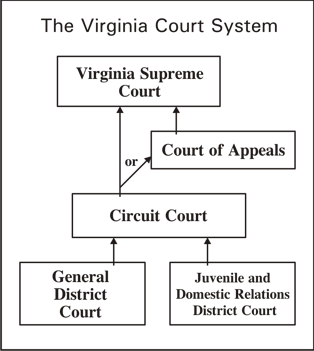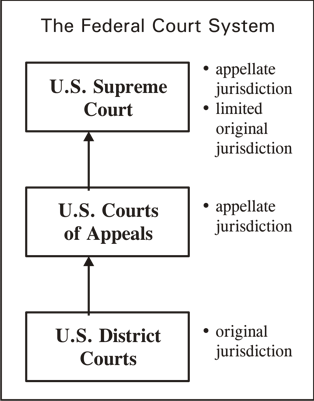| Review Questions for CE 10 in Fasttrack Civics - The
Court System 1. Why is the court system in America called a "dual court system"? 2. What document is the jurisdiction and organization of the federal court system based on? 3. What document is the jurisdiction and organization of the Virginia court system based on? 4. What does it mean to say the U.S. Supreme Court has the power of judicial review? 5. Does the Virginia Supreme Court have the power of judicial review within the state of Virginia? 6. What is the name of the famous legal case that established the power of judicial review at the federal level? Use the chart below to help you answer questions 7 to 12.  7. Which Virginia court hears felony criminal cases, such as a murder or armed robbery, by an adult? 8. Which Virginia court would most likely hear a civil case involving a small amount of money? 9. In which court can the person accused of a crime have his or her case heard by a jury? 10. In which court would a 16 year old accused of stealing a computer be heard? 11. In which court would a misdemeanor (a less serious crime) committed by an adult most likely be heard? 12. What do the arrows on the Virginia Courts chart represent or show? Use the chart below to help you answer questions 13 - 16.  13. In which court do most federal cases, criminal or civil, begin? 14. What does it mean to say the U.S. District Courts have “original jurisdiction” in most federal court cases? 15. What does it mean to say that the U.S. Court of Appeals has "appellate jurisdiction"? 16. What court is the highest court in the federal court system? 17. What document must the U.S. Supreme Court consider as "the supreme law of the land" when it decides any case? 18. Do Virginia courts have to follow the Virginia Constitution only, the U.S. Constitution only, or both? 19. What is the difference between a criminal case and a civil case? 20. Put these steps of a criminal case in proper order: trial; arrest; arraignment; bail hearing; appeals. 21. Put these steps of a civil case in proper order: appeals; complaint filed by plaintiff; trial. 22. Who is the defendant in a court case? 23. Who is the plaintiff in a civil court case? 24. In a civil case, the court settles a ___________ between two parties. (Answer choices: physical fight, disagreement, crime.) 25. What happens at the arraignment if you are arrested and accused of a crime? 26. What is "bail"? 27. What is the term for the level of evidence officials need to make an arrest or obtain a search warrant? (Answer choices: proof, suspicion, probable cause.) 28. What does the legal phrase "due process" or "due process of law" mean? 29. What amendment requires the national (federal) government to follow due process? 30. What amendment requires state and local governments to follow due process? Copyright 2007, 2015 by David Burns All rights reserved www.fasttrackteaching.com/civics |